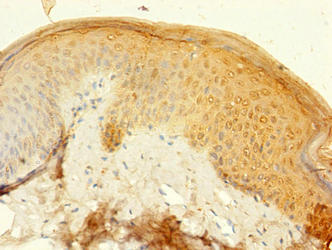![Cytokeratin, Acidic (Type I or LMW) (Epithelial Marker)(AE-1), CF405S conjugate, 0.1mg/mL [26628-22-8] Cytokeratin, Acidic (Type I or LMW) (Epithelial Marker)(AE-1), CF405S conjugate, 0.1mg/mL [26628-22-8]](https://biotium.com/wp-content/uploads/2021/02/view_image-28.jpeg)
Cytokeratin, Acidic (Type I or LMW) (Epithelial Marker)(AE-1), CF405S conjugate, 0.1mg/mL [26628-22-8]
BNC040252
TargetKRT77
Product group Antibodies
Overview
- SupplierBiotium
- Product NameCytokeratin, Acidic (Type I or LMW) (Epithelial Marker)(AE-1), CF405S conjugate, 0.1mg/mL
- Delivery Days Customer9
- CertificationResearch Use Only
- ClonalityMonoclonal
- Clone IDAE-1
- Concentration0.1 mg/ml
- ConjugateOther Conjugate
- Gene ID374454
- Target nameKRT77
- Target descriptionkeratin 77
- Target synonymsCK-1B; cytokeratin-1B; K1B; K77; keratin 1B; keratin 77, type II; keratin, type II cytoskeletal 1b; KRT1B; type-II keratin Kb39
- HostMouse
- IsotypeIgG1
- Protein IDQ7Z794
- Protein NameKeratin, type II cytoskeletal 1b
- Scientific DescriptionThis MAb recognizes the 56. 5 kDa (CK10); 50 kDa (CK14); 50 kDa (CK15); 48 kDa (CK16); 40 kDa (CK19) keratins of the acidic (Type I or LMW) subfamily. Twenty human keratins are resolved with two-dimensional gel electrophoresis into acidic (pI , 48, 46, 45, and 40 kDa. MAb AE3 recognizes the 65-67, 64, 59, 58, 56, and 52 kDa keratins of basic subfamily. Many studies have shown the usefulness of keratins as markers in cancer research and tumor diagnosis. AE1/AE3 is a broad spectrum anti pan-keratin antibody cocktail, which differentiates epithelial tumors from non-epithelial tumors e. g. squamous vs. adenocarcinoma of the lung, liver carcinoma, breast cancer, and esophageal cancer. Primary antibodies are available purified, or with a selection of fluorescent CF® Dyes and other labels. CF® Dyes offer exceptional brightness and photostability. Note: Conjugates of blue fluorescent dyes like CF®405S and CF®405M are not recommended for detecting low abundance targets, because blue dyes have lower fluorescence and can give higher non-specific background than other dye colors.
- SourceAnimal
- Storage Instruction2°C to 8°C
- UNSPSC12352203


![IHC-P analysis of human colon carcinoma section using GTX02666 Keratin 77 antibody [KRTL/4440R].](https://www.genetex.com/upload/website/prouct_img/normal/GTX02666/GTX02666_20210319_IHC-P_1_w_23053122_356.webp)


